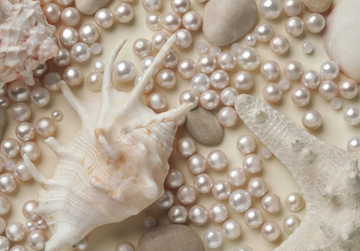Pearls, with their serene luster and timeless appeal, require a special touch when it comes to setting them in a ring. Unlike harder gemstones that can withstand more aggressive setting techniques, pearls demand a gentle approach to preserve their delicate surface and inherent beauty. Setting a pearl is less about force and more about finesse, a delicate dance between gem and metal. Let’s explore the intricacies of how pearls are expertly set into rings, revealing the techniques and considerations that ensure a secure and stunning final product.
I. Understanding the Pearl’s Unique Challenges
Before delving into setting techniques, it’s crucial to acknowledge the pearl’s inherent vulnerabilities:
- Softness: Pearls are relatively soft (2.5 - 4.5 on the Mohs Hardness Scale), making them easily susceptible to scratches and abrasions.
- Porosity: Their porous nature means they can absorb oils, chemicals, and even water, potentially affecting their luster and color.
- Sensitivity to Heat: Pearls are sensitive to heat, which can damage their surface and affect their nacre (the iridescent coating).
- Drilling (Often): Unlike faceted gemstones with naturally defined edges, pearls often require drilling for setting, which can weaken their structure if not done correctly.
These factors dictate that setting techniques must be gentle, non-abrasive, and avoid excessive pressure or heat.
II. The Principal Setting Styles: A Gentle Embrace
Several setting styles are commonly employed for pearl rings, each offering a unique balance of security and aesthetics:
-
Bezel Setting:
- Description: A metal rim encircles the pearl, holding it securely in place. This provides maximum protection from scratches and impacts.
- Process: The bezel is typically formed from a thin strip of metal that is carefully shaped around the pearl. The metal is then gently pushed over the edge of the pearl to hold it in place.
- Advantages: Excellent protection, minimal exposure to chemicals, smooth and comfortable to wear.
- Disadvantages: Can obscure the pearl’s girdle (widest point), potentially reducing its brilliance, and is expensive.
-
Prong Setting:
- Description: Metal prongs (typically 4 or 6) grasp the pearl, holding it in place. This allows more light to reach the pearl, enhancing its luster.
- Process: Prongs are carefully positioned around the pearl, and then gently bent over to secure it. The prongs must be smooth and rounded to avoid scratching the pearl’s surface.
- Advantages: Allows maximum light exposure, showcasing the pearl’s beauty. Cheaper that other settings
- Disadvantages: Offers less protection than a bezel setting, requires careful prong maintenance to prevent loosening, and could allow the pearl to fall out.
-
Peg Setting (Also known as Glue Setting):
- Description: A small metal peg is attached to the ring, and a hole is drilled into the pearl to accommodate the peg. The pearl is then glued onto the peg.
- Process: The peg must be precisely sized to fit the hole in the pearl. High-quality jewelry epoxy is used to create a strong and durable bond.
- Advantages: Simple and relatively inexpensive, allows for creative designs.
- Disadvantages: Glue can weaken over time, potentially leading to the pearl detaching, prone to collecting dirt and grime around the glue joint.
-
Illusion Setting:
- Description: A pearl sits atop a highly reflective metal surface which is often textured or faceted to create the illusion of a larger pearl or to add more sparkle.
- Process: This setting often combines elements of prong or bezel settings with careful placement of the reflective metal.
- Advantages: Can make a smaller pearl appear larger and more visually impactful.
- Disadvantages: Can be more expensive than simpler settings. Requires expert craftsmanship to create the desired illusion.
-
Threaded Setting:
- Description: Used primarily for rings featuring multiple small pearls. The pearls are drilled and threaded onto a wire or string that is then secured to the ring.
- Process: Requires precise drilling of each pearl and careful threading to ensure a secure and uniform arrangement.
- Advantages: Suitable for intricate designs with multiple pearls.
- Disadvantages: Can be time-consuming and labor-intensive, may require periodic restringing.
III. The Jeweler’s Gentle Touch: Essential Techniques
Regardless of the setting style, skilled jewelers employ specific techniques to protect the pearl during the setting process:
- Customization: Every pearl is unique, so the setting must be carefully adjusted to fit the specific pearl’s size and shape.
- Precision Drilling: When drilling is required, jewelers use specialized drill bits and techniques to minimize the risk of cracking or chipping the pearl.
- Gentle Pressure: Settings are carefully tightened or formed using gentle pressure to avoid damaging the pearl’s surface.
- Heat Avoidance: Jewelers take precautions to avoid exposing the pearl to excessive heat, such as using heat sinks or working in stages with cooling periods.
- Protective Coatings: In some cases, jewelers may apply a thin layer of protective coating to the pearl’s surface to prevent scratches during the setting process.
IV. Modern Innovations: Exploring New Horizons
While traditional setting techniques remain popular, modern innovations are expanding the possibilities for pearl ring design:
- Laser Welding: Precise laser welding techniques allow jewelers to create intricate settings with minimal heat exposure to the pearl.
- Computer-Aided Design (CAD): CAD technology enables jewelers to design and create custom settings that perfectly cradle the pearl and maximize its brilliance.
- New Adhesives: Advances in adhesive technology are yielding stronger and more durable jewelry epoxies, improving the reliability of peg settings.
V. A Final Note: The Importance of Expertise
Setting a pearl in a ring is a delicate art that requires specialized knowledge and skills. It’s crucial to entrust your pearl ring to a qualified jeweler with experience in working with these unique gems. A skilled jeweler will not only create a beautiful setting but also ensure the long-term security and integrity of your precious pearl. By understanding the challenges and techniques involved, you can appreciate the artistry and craftsmanship that go into creating a stunning pearl ring that will be cherished for generations.







